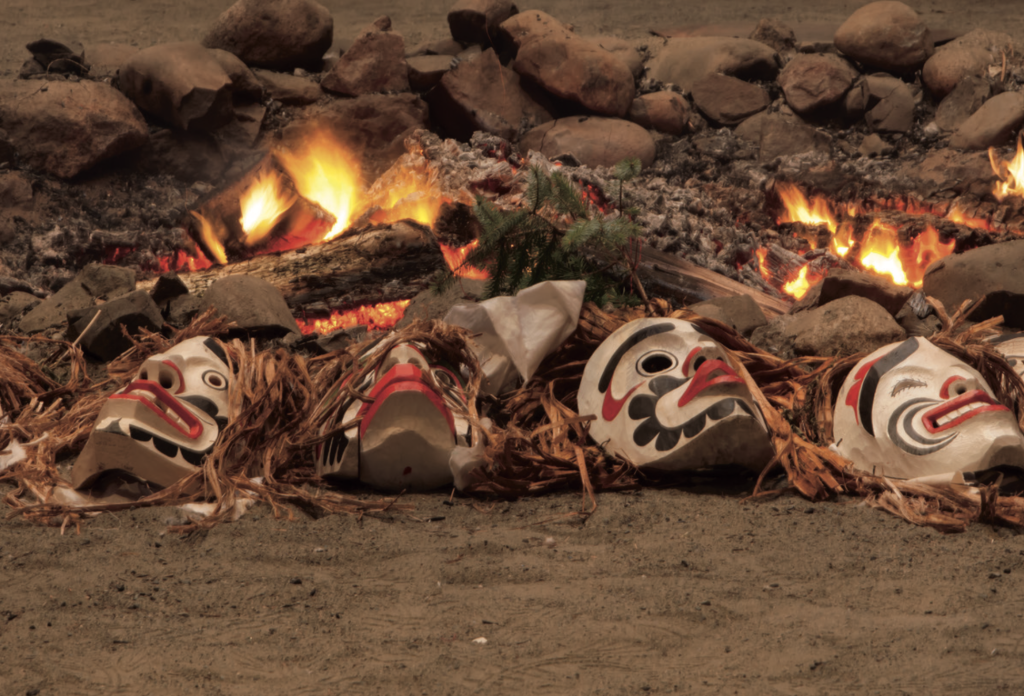The Newsroom
To See and to Burn: A Story shared by Candice Hopkins
Leading up to the National Day for Truth and Reconciliation on September 30, Figure 1 is sharing excerpts, quotes and stories from select Indigenous Art + Culture titles. This story shared by Candice Hopkins is excerpted from Beau Dick: Devoured by Consumerism.
I remember the first time I saw one of Beau Dick’s masks. The mask was large. Too large to wear, made instead to hang on a gallery wall. Carved wood so dark it appeared charred. The face was both male and female. Long, coarse black hair fell to either side, mixing with the figure’s mustache, which curled over red lips fixed in a permanent O as though howling. I stood transfixed by this object, which seemed to hover at the threshold between the nameable and the unnameable. As Jean-Luc Nancy observes: “The fetish is in fact the artifice par excellence or par essence” (the word “fetish” deriving from the Portuguese feitifo, “artificial”). The mask was a fetish, yet it refused my fetishization, emerging instead from the context of ritual as an object of disguise, transformation, and metamorphosis. Its artifice is what lent it life. “The fetish is the being-there of a desire, an expectation, an imminence, a power and its presentiment, a force interred in the form and exhumed by it.”4 It was the being-there of desire that held my gaze. Is an object’s material nature a source of its power, or does that power reside somewhere else? Can an object disrupt the power relations that are set into motion the moment that it is placed in a gallery or museum? Can it disrupt the (still prevalent) impulse to attach the word “primitive” to this object despite increasingly broad definitions of artistic practice?
In the summer of 2012, Dick performed something of a power trans-position. It began with a solo exhibition at a Vancouver gallery that presented a series of carved masks and sculptures. Midway through the show’s run, forty masks were removed and taken to an island off the coast of British Columbia, to the small settlement of Alert Bay, where they were ceremonially burned. The artist invited his community, as well as artists, curators, and gallerists, to Alert Bay to witness the act. For Dick, the burning was not an end but a beginning, the masks’ destruction part of a larger cycle bound with the obligation that accompanies tradition and the strict protocols of ritual. As the artist explained about the objects following the burning: “What we have to do is recreate them — and that keeps them alive.”
At a time when power is more deeply tied to money than ever before, Dick’s project was a means to short-circuit the commodification of Northwest Coast ceremonial objects, preventing them from becoming fetishes in the service not of ritual but of capital. For the artist, ensuring that these objects are used as intended “takes away any monetary value they have in this world and makes [them] real.” Destruction becomes an active part of creation by detaching objects from a confining system. With his gesture, Dick has gotten at something: at the moment that an object becomes a commodity, its true nature dissipates, sliding like ashes between spread fingers. The source of resistance is the desire to be real. In Indigenous Northwest Coast societies, the most valuable objects cannot be owned. Passed down through generations, these ceremonial objects are hidden away in decorated boxes for safekeeping when they are not in use. The masks exist in the cyclical time of ritual. Ceremony ruptures the division between the historical and the contemporary—these objects thread their way through time, being continually remade in the same manner irrespective of changes around them.
Beau Dick’s family and friends, including LaTiesha Fazakas, the author of Beau Dick: Devoured by Consumerism were present at a ground-awakening ceremony at the Vancouver Art Gallery’s future location earlier this month.
Actions you can take this week, and on the National Day for Truth and Reconciliation:
- Join daily lunch and learns hosted by the National Centre for Truth and Reconciliation
- Attend a National Day for Truth and Reconciliation event near you
- Buy from an Indigenous artist, give an Indigenous-led podcast a listen or check out new music by Indigenous artists
- Read a book by an Indigenous author
- Make a donation to the Indian Residential School Survivors Society
- Sign up for a free course such as Indigenous Canada at the University of Albert
Figure 1 Publishing is located in the traditional, unceded territory of the xʷməθkʷəy̓əm (Musqueam), Sḵwx̱wú7mesh (Squamish) and səl̓ilw̓ətaʔɬ (Tsleil-Waututh) peoples. We recognize that British Columbia and Canada were created through organized dispossession and colonial violence, and we commit to work responsibly and constructively with Indigenous authors and contributors to help create a vital present and future for Indigenous and non-Indigenous communities living on these lands.
